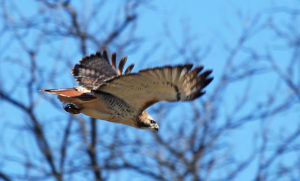Ragtag Burn Crew
Minutes into the steep climb, it’s clear I’ve become soft over the winter. Shouldering 4 gallons of water in my backpack pump, a drip torch in one hand, and the other a three gallon water jug, I heed the protest of my body and slow my pace. Soon, I hope, I’ll get my burn-season legs back. The fire crackles to life at the ridge top. Satisfied with its behavior, I lay out two short parallel lines of fire. Slowly I work my way down the slope, extending the lines of fire and leaving behind a long, blackened 15-foot swath. With my intense focus on managing the fire, I’m slow to recognize that I’m not alone.
Burn season usually arrives very fast. Combine this with a typically short time window to get all the burns done, it pays to do a lot of fire prep work to help expedite the burn. Today, I’m burning in a fire break through an oak savanna in steep and rugged terrain. Doing this on “burn day,” when conditions are drier and warmer, greatly amplifies the difficulty in ignition and suppression efforts. With the break in prior to the big burn day, the line crew simply has to ignite off the blackened edge with minimal suppression efforts needed, greatly reducing the amount of time and resources expended on this line.

photo by Carl Kurtz
I’ve reached a transition area where the fuel switches from grasses to oak leaves, easing the intensity of the fire. I use the opportunity to refill my backpack and relax awhile. A white-breasted nuthatch is close by, busily scurrying up and down the base of trees along the front edge of the right fire line. Also close by is a black-capped chickadee. It’s repeatedly flying back and forth from the front edge of the left fire line to nearby oak sapling branches. Looking back farther up the lines, I see two Eastern bluebirds, one at each fire line, darting back and forth between tree branches and the edge of the fire lines. I notice a large bird shadow, and look up to see a red tailed hawk circling over the whole operation.
Look at that, I smile, I have a burn crew with me after all. On my right line, the nuthatch is first water and bluebird #1 is second water. On my left line, the chickadee is first water and bluebird #2 is second water. And my lookout is the hawk. A ragtag burn crew!
These critters aren’t here to help me, of course. They’re here for food – various insects for the small birds and perhaps a vole or mouse for the hawk. The interesting question is how they learned this behavior – equating fire with an opportunity for food?
There are likely many examples of wild animals learning to exploit human activities for their benefit. One that quickly comes to mind is whitetail deer and the chainsaw. I swear there are times in late winter when the deer show up to a work site roughly 1 millisecond after I leave the area. They must be called in by the sound of the chainsaw, wait nearby in anticipation of juicy tree branch buds, and rush in soon after my departure to beat other herd members to the choicest morsels.
Wild animals recognizing and utilizing fire as a hunting opportunity is fascinating. I wonder if it extends further than avian predators. After all, birds can just take to the sky if things get too hot. Are there examples of mammals exploiting fire for their hunting benefit? I know our house cat, if it gets the chance, is attracted to fire. Apparently, it instinctively seems to equate burning grass and leaves as a good chance for a mouse.
Did my ragtag burn crew learn these skills over the short time we have been using prescribed fire on our land? Or is it instinctual, ingrained in their DNA? Or, perhaps, instinct is nothing more than hundreds or thousands of years of learning?
We know Native Americans worked these lands for thousands of years prior to our (European) arrival. Their tool of choice was fire.
My bet, if we could turn the page back to a time when the landscape was cultivated by fire, we’d find on this very hillside a young Ho-Chunk man holding a fire torch. He’s not alone, accompanied by nuthatches, chickadees, bluebirds, hawks and likely many others critters that evolved in an ecosystem of fire.


